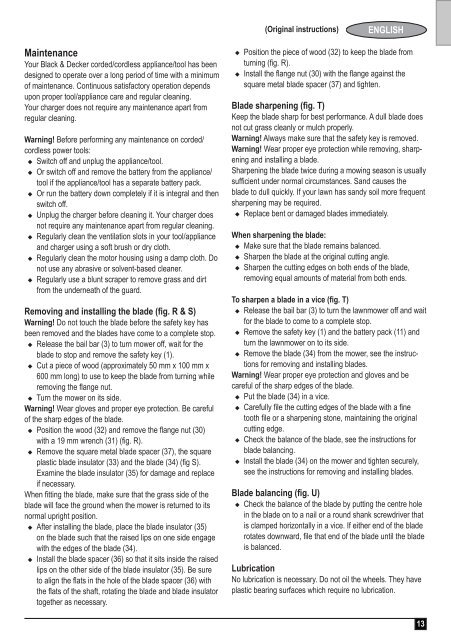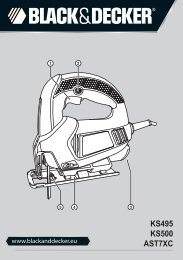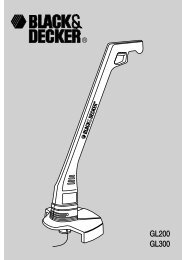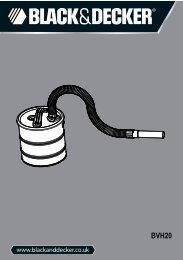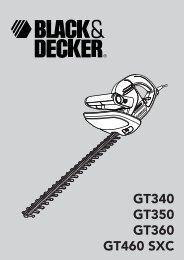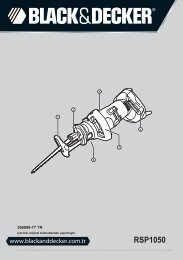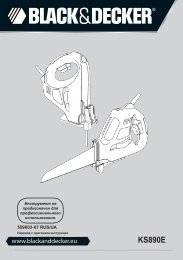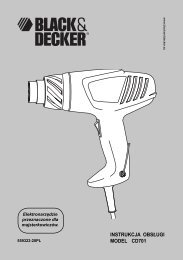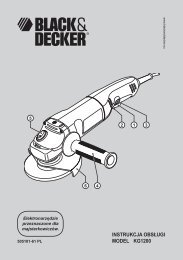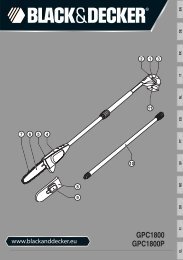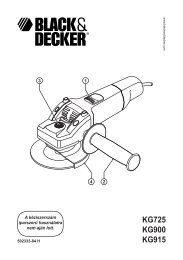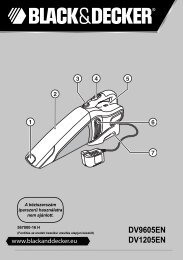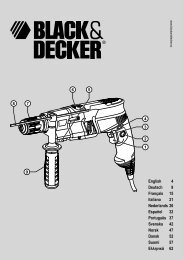GRC4736SD - Service - Black & Decker
GRC4736SD - Service - Black & Decker
GRC4736SD - Service - Black & Decker
You also want an ePaper? Increase the reach of your titles
YUMPU automatically turns print PDFs into web optimized ePapers that Google loves.
Maintenance<br />
Your <strong>Black</strong> & <strong>Decker</strong> corded/cordless appliance/tool has been<br />
designed to operate over a long period of time with a minimum<br />
of maintenance. Continuous satisfactory operation depends<br />
upon proper tool/appliance care and regular cleaning.<br />
Your charger does not require any maintenance apart from<br />
regular cleaning.<br />
Warning! Before performing any maintenance on corded/<br />
cordless power tools:<br />
u Switch off and unplug the appliance/tool.<br />
u Or switch off and remove the battery from the appliance/<br />
tool if the appliance/tool has a separate battery pack.<br />
u Or run the battery down completely if it is integral and then<br />
switch off.<br />
u Unplug the charger before cleaning it. Your charger does<br />
not require any maintenance apart from regular cleaning.<br />
u Regularly clean the ventilation slots in your tool/appliance<br />
and charger using a soft brush or dry cloth.<br />
u Regularly clean the motor housing using a damp cloth. Do<br />
not use any abrasive or solvent-based cleaner.<br />
u Regularly use a blunt scraper to remove grass and dirt<br />
from the underneath of the guard.<br />
Removing and installing the blade (fig. R & S)<br />
Warning! Do not touch the blade before the safety key has<br />
been removed and the blades have come to a complete stop.<br />
u Release the bail bar (3) to turn mower off, wait for the<br />
blade to stop and remove the safety key (1).<br />
u Cut a piece of wood (approximately 50 mm x 100 mm x<br />
600 mm long) to use to keep the blade from turning while<br />
removing the flange nut.<br />
u Turn the mower on its side.<br />
Warning! Wear gloves and proper eye protection. Be careful<br />
of the sharp edges of the blade.<br />
u Position the wood (32) and remove the flange nut (30)<br />
with a 19 mm wrench (31) (fig. R).<br />
u Remove the square metal blade spacer (37), the square<br />
plastic blade insulator (33) and the blade (34) (fig S).<br />
Examine the blade insulator (35) for damage and replace<br />
if necessary.<br />
When fitting the blade, make sure that the grass side of the<br />
blade will face the ground when the mower is returned to its<br />
normal upright position.<br />
u After installing the blade, place the blade insulator (35)<br />
on the blade such that the raised lips on one side engage<br />
with the edges of the blade (34).<br />
u Install the blade spacer (36) so that it sits inside the raised<br />
lips on the other side of the blade insulator (35). Be sure<br />
to align the flats in the hole of the blade spacer (36) with<br />
the flats of the shaft, rotating the blade and blade insulator<br />
together as necessary.<br />
(Original instructions)<br />
ENGLISH<br />
u Position the piece of wood (32) to keep the blade from<br />
turning (fig. R).<br />
u Install the flange nut (30) with the flange against the<br />
square metal blade spacer (37) and tighten.<br />
Blade sharpening (fig. T)<br />
Keep the blade sharp for best performance. A dull blade does<br />
not cut grass cleanly or mulch properly.<br />
Warning! Always make sure that the safety key is removed.<br />
Warning! Wear proper eye protection while removing, sharpening<br />
and installing a blade.<br />
Sharpening the blade twice during a mowing season is usually<br />
sufficient under normal circumstances. Sand causes the<br />
blade to dull quickly. If your lawn has sandy soil more frequent<br />
sharpening may be required.<br />
u Replace bent or damaged blades immediately.<br />
When sharpening the blade:<br />
u Make sure that the blade remains balanced.<br />
u Sharpen the blade at the original cutting angle.<br />
u Sharpen the cutting edges on both ends of the blade,<br />
removing equal amounts of material from both ends.<br />
To sharpen a blade in a vice (fig. T)<br />
u Release the bail bar (3) to turn the lawnmower off and wait<br />
for the blade to come to a complete stop.<br />
u Remove the safety key (1) and the battery pack (11) and<br />
turn the lawnmower on to its side.<br />
u Remove the blade (34) from the mower, see the instructions<br />
for removing and installing blades.<br />
Warning! Wear proper eye protection and gloves and be<br />
careful of the sharp edges of the blade.<br />
u Put the blade (34) in a vice.<br />
u Carefully file the cutting edges of the blade with a fine<br />
tooth file or a sharpening stone, maintaining the original<br />
cutting edge.<br />
u Check the balance of the blade, see the instructions for<br />
blade balancing.<br />
u Install the blade (34) on the mower and tighten securely,<br />
see the instructions for removing and installing blades.<br />
Blade balancing (fig. U)<br />
u Check the balance of the blade by putting the centre hole<br />
in the blade on to a nail or a round shank screwdriver that<br />
is clamped horizontally in a vice. If either end of the blade<br />
rotates downward, file that end of the blade until the blade<br />
is balanced.<br />
Lubrication<br />
No lubrication is necessary. Do not oil the wheels. They have<br />
plastic bearing surfaces which require no lubrication.<br />
13


